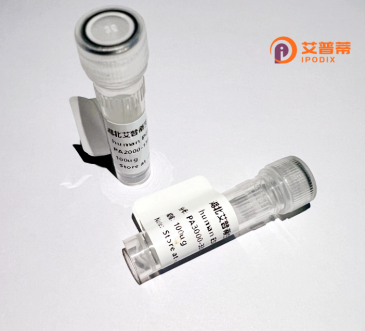
| 纯度 | >90%SDS-PAGE. |
| 种属 | Human |
| 靶点 | SLC25A46 |
| Uniprot No | Q96AG3 |
| 内毒素 | < 0.01EU/μg |
| 表达宿主 | E.coli |
| 表达区间 | 1-418 aa |
| 活性数据 | MHPRRPDGFDGLGYRGGARDEQGFGGAFPARSFSTGSDLGHWVTTPPDIPGSRNLHWGEKSPPYGVPTTSTPYEGPTEEPFSSGGGGSVQGQSSEQLNRFAGFGIGLASLFTENVLAHPCIVLRRQCQVNYHAQHYHLTPFTVINIMYSFNKTQGPRALWKGMGSTFIVQGVTLGAEGIISEFTPLPREVLHKWSPKQIGEHLLLKSLTYVVAMPFYSASLIETVQSEIIRDNTGILECVKEGIGRVIGMGVPHSKRLLPLLSLIFPTVLHGVLHYIISSVIQKFVLLILKRKTYNSHLAESTSPVQSMLDAYFPELIANFAASLCSDVILYPLETVLHRLHIQGTRTIIDNTDLGYEVLPINTQYEGMRDCINTIRQEEGVFGFYKGFGAVIIQYTLHAAVLQITKIIYSTLLQNNI |
| 分子量 | 72.6 kDa |
| 蛋白标签 | GST-tag at N-terminal |
| 缓冲液 | PBS, pH7.4, containing 0.01% SKL, 1mM DTT, 5% Trehalose and Proclin300. |
| 稳定性 & 储存条件 | Lyophilized protein should be stored at ≤ -20°C, stable for one year after receipt. Reconstituted protein solution can be stored at 2-8°C for 2-7 days. Aliquots of reconstituted samples are stable at ≤ -20°C for 3 months. |
| 复溶 | Always centrifuge tubes before opening.Do not mix by vortex or pipetting. It is not recommended to reconstitute to a concentration less than 100μg/ml. Dissolve the lyophilized protein in distilled water. Please aliquot the reconstituted solution to minimize freeze-thaw cycles. |
以下是关于重组人SLC25A46蛋白的3篇代表性文献及其摘要概括:
---
1. **文献名称**:*Mutations in SLC25A46 cause a novel autosomal recessive neurodegenerative disorder*
**作者**:Abrams et al. (2015)
**摘要**:该研究首次报道SLC25A46基因突变导致常染色体隐性遗传的神经退行性疾病(如视神经萎缩和小脑萎缩),通过功能实验证明SLC25A46调控线粒体动力学,其突变会导致线粒体过度分裂及神经元功能障碍。
2. **文献名称**:*SLC25A46 modulates mitochondrial membrane potential and interacts with the fusion machinery*
**作者**:Wan et al. (2016)
**摘要**:研究通过CRISPR敲除细胞模型,发现SLC25A46缺失引起线粒体片段化、膜电位降低及自噬增强,并揭示其与线粒体融合蛋白MFN2、OPA1的相互作用,表明其在线粒体融合和能量代谢中的关键作用。
3. **文献名称**:*Structural insights into SLC25A46-mediated mitochondrial lipid transfer*
**作者**:Saita et al. (2018)
**摘要**:利用重组表达的SLC25A46蛋白进行结构解析和生化分析,揭示其作为线粒体外膜脂质转运蛋白的功能,可能通过转运磷脂酸参与线粒体膜形态的维持及与其他细胞器的互作。
---
以上研究涵盖了SLC25A46在疾病关联、线粒体动力学调控、结构功能等方向的核心进展。如需扩展,可进一步检索近年关于其与内质网互作或代谢调控的研究。
SLC25A46 is a member of the solute carrier family 25 (SLC25), a group of mitochondrial transport proteins that shuttle metabolites, nucleotides, and cofactors across the inner mitochondrial membrane. Unlike most SLC25 family members characterized as metabolite transporters, SLC25A46 lacks conserved substrate-binding residues, suggesting divergent functions. Recent studies reveal its critical role in mitochondrial dynamics and cellular homeostasis. It localizes to the mitochondrial outer membrane and interacts with proteins involved in mitochondrial fusion (e.g., MFN2) and fission (e.g., DRP1), modulating cristae architecture and lipid composition.
Mutations in the SLC25A46 gene are linked to neurological disorders, including Charcot-Marie-Tooth disease type 2. Leigh syndrome, and optic atrophy, often associated with aberrant mitochondrial morphology and bioenergetic defects. These pathogenic variants disrupt mitochondrial networking, ER-mitochondria tethering, and mitophagy, underscoring its importance in mitochondrial quality control.
Recombinant human SLC25A46 protein is widely used to study its structure-function relationships, interactions, and pathogenic mechanisms. Expressed in systems like E. coli or mammalian cells, it aids in deciphering its non-canonical transporter activity, post-translational modifications, and role in apoptosis or metabolic signaling. Its study holds therapeutic potential for mitochondrial disorders and age-related neurodegenerative diseases.
×